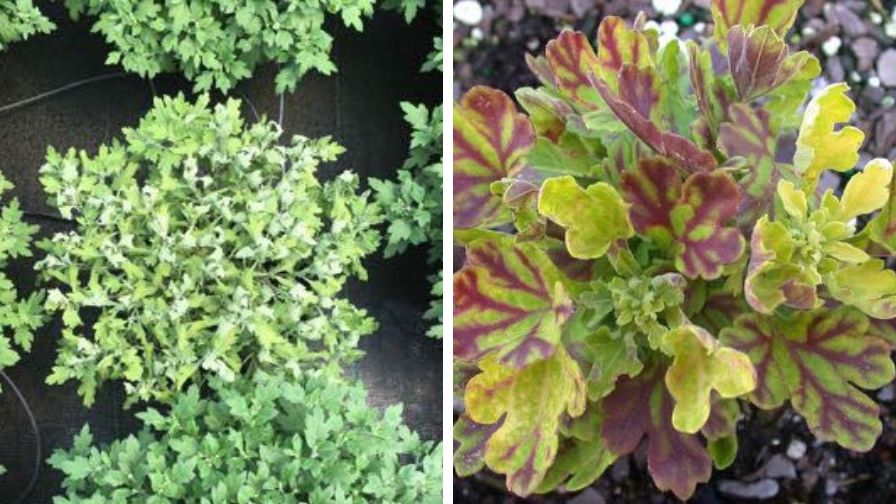
Pythium wilting (L) and root rot purpling (R) | Brian Whipker
In late-season garden mums, prior to shipping, there is a common and disappointing chance of disease symptom development. Recently in published e-Gro alerts, Brian E. Whipker and Patrick Veazie of North Carolina State University covered two recurring issues to look out for and late-season mum crop management strategies to both prevent the problems and deal with them when they occur.
Garden Mums – Fusarium and Pythium Wilting Issues
Typical symptoms of Fusarium spp. and Pythium spp. infections result in a wilting pattern throughout the plant and the yellowing of leaves. Initially, a Fusarium infection is more isolated to one side, but will eventually spread to encompass the whole plant, mirroring a Pythium infection. Therefore, depending on the rate of infection, it can be difficult to properly diagnose between the two diseases without lab work.
Proper fungicide applications can prevent and control both Fusarium and Pythium wilting issues before they appear. However, once either disease infects a garden mum, there is no reversible treatment. The best available option is to remove and isolate the plant, preventing the spread of infection to surrounding crops through irrigation and other communicable means.
Garden Mums – The Reddening and Purpling of Leaves
Beyond its initial wilting pattern, one easier way to identify between a Fusarium and Pythium infection by sight is the presence of root rot. The state of roots often remains intact and healthy when infected by Fusarium, but that’s not the case for Pythium.
Pythium root rot, paired with the onset of cold temperatures from late-season management in the transition from summer to fall, can often result in “an uptick of anthocyanin production in the leaves,” which can cause red foliage (reddening) compared to the usual symptom of yellowing with wilted leaves.
Other common ways that red leaf symptoms can occur in late-season garden mums include stem cracks and phosphorus deficiency.
Stem cracks often occur through mechanical (equipment) damage, heavy/weak stems, and cold and windy weather, which is often more present in autumn.
As for phosphorus deficiency, the symptoms present themselves differently depending on whether the weather is warm or cold. In cold weather, lower leaf reddening and purpling are present, while warm weather instead presents more typical yellowing spotting on leaves.
For more information regarding late-season garden mum crop management and disease control strategies, please read the full e-Gro (Electronic Grower Resources Online) alerts “The Diseases Your Mum Warned You About!“ and “Garden Mums: The Possibilities of Seeing Red.” Additional and current e-Gro alert pieces from Volume 13 (2024) can be found online.

